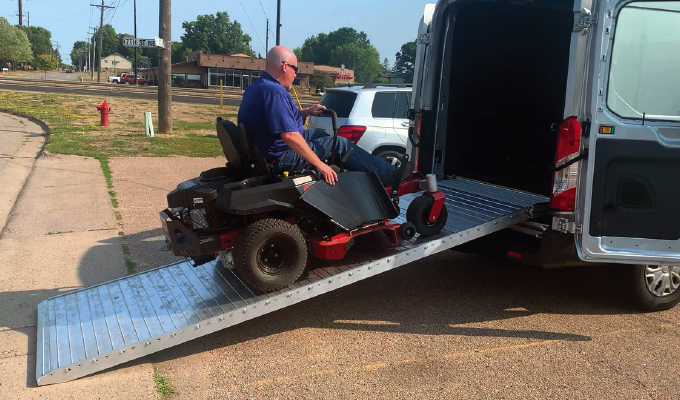There are many aftermarket ramp accessories on the market today, and each style has its own advantages and disadvantages. Each style has also found favor among certain audiences.
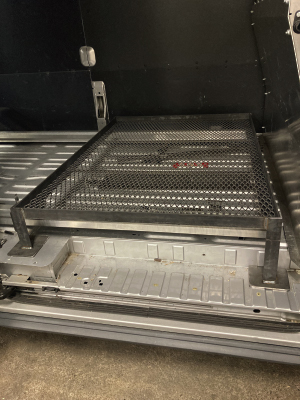
When it comes to ramps for van applications, folding and swivel-mount ramps are among the most popular of the ramp styles. Because they nest just inside the rear door of a van’s cargo area, folding and swivel ramps can be quickly deployed when needed and retracted and stored once their work is done. However, to remain agile enough to be operated by one person, folding and swivel ramps must be made of lightweight materials that achieve and maintain their structural integrity, in part through the use of side rails. Though the side rails are part of the key to these systems’ functionality, their height along the edges of a ramp also pose an impediment for some uses.
“When using a ramp for lawn equipment, pronounced side rails can cause clearance problems for our mower decks and other equipment,” says Bradford McAtee, president of VIP Service Group, a company that offers lawn and turf care as well as snow and ice management services. “Springs and locking mechanisms associated with folding and swivel ramps also pose a problem.”
McAtee notes that side rails and the obstructions that connect it to the vehicle deck had kept him from entertaining the use of vans to transport equipment to and from worksites. “It was a little frustrating because vans are the perfect vehicle for some of our equipment and applications,” McAtee explains.
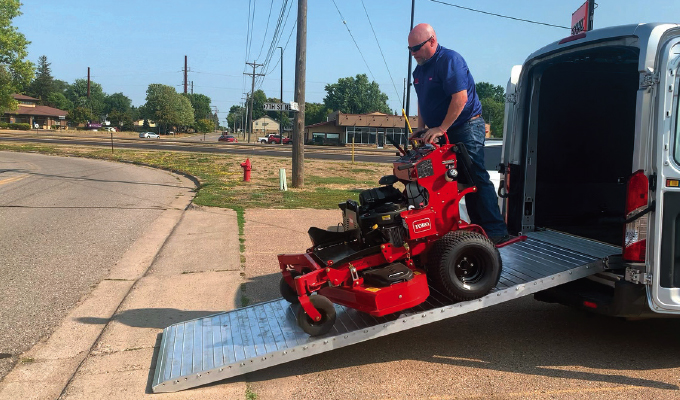
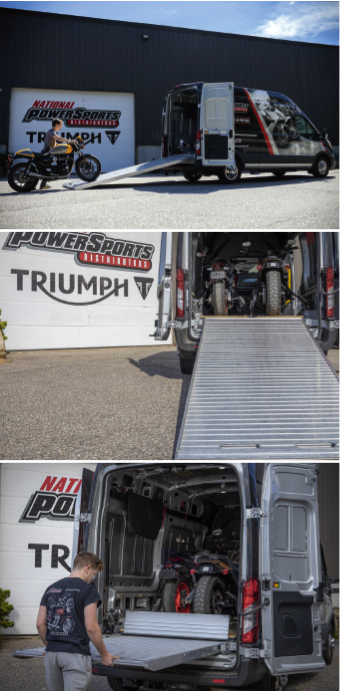
CENTER: The 48-inch-wide ramp has a flat surface edge-to-edge with raised traction ridges and no side rails.
BOTTOM: The rugged yet lightweight one-piece, heavy-duty Hide-A-Ramp is easily deployed from the rear of the van. Two hand holes enable users to secure a good grip as they pull the 10-ft-long ramp from its housing.
HIDDEN SOLUTION
Enter the Hide-A-Ramp. National Fleet Products’ Hide-A-Ramp is a complete departure from similar offerings on the market. Designed for the Ford Transit, the Hide-A-Ramp literally hides itself under its own integrated, low-profile deck housing and slides out to provide unencumbered van entry.
The top of the Hide-A-Ramp’s housing rises just 6 inches above the Transit’s original deck and becomes a sturdy new floor surface that can accommodate loads of up to 2,500 lbs. The Hide-A-Ramp’s deck allows users to move hand trucks and wheeled vehicles such as lawn mowers, lawn tractors, and more in and out of a van with ease.
The 48-inch-wide ramp has a flat surface edge-to-edge with raised traction ridges and no side rails. By eliminating the side rails, the ramp’s design allows wheeled equipment to extend over the edge of the ramp without getting hung up.
“When we first saw the Hide-A-Ramp’s design, we were impressed with its clever under-deck storage concept and very flat ramp surface,” McAtee says. “It was clear that it could be the solution that would make van transportation of some of our equipment feasible.”
The rugged yet lightweight one-piece, heavy-duty Hide-A-Ramp is easily deployed from the rear of the van. Two hand holes enable users to secure a good grip as they pull the 10-ft-long ramp from its housing. Once fully extended and placed on the ground, the ramp’s beveled leading edge and top make for a smooth transition from ground to ramp to interior deck—all at a slope of 23 degrees.
“The Hide-A-Ramp has a very user-friendly design and allows one-man operation,” McAtee observes. “We have four Hide-A-Ramps in use, and my folks can get to their jobsites, get their jobs done, and get on to their next jobs quickly—it’s very efficient.
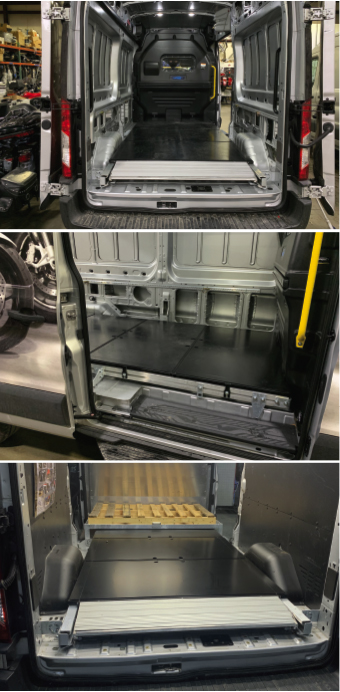
CENTER: The top of the Hide-A-Ramp’s housing rises just 6 inches above the Transit’s original deck and becomes a sturdy new floor surface that can accommodate loads of up to 2,500 lbs.
BOTTOM: The Hide-A-Ramp’s pallet trays are designed to accommodate a standard pallet. The trays align with the Transit’s side doors, allowing forklift loading directly into the trays.
PALLET ABLE
The Hide-A-Ramp system is also available with an optional pallet tray that allows operators to load palletized materials such as fertilizer, salt, or sand through the side door for easy access when replenishing hoppers before unloading vehicles at a worksite.
“All four of our Hide-A-Ramps are outfitted with pallet trays, and it’s a great feature,” McAtee says. “We used them for salt and calcium chloride last winter, and we’re using them for bulk lawn chemicals this summer.”
The Hide-A-Ramp’s pallet trays are designed to accommodate a standard pallet. The trays align with the Transit’s side doors, allowing forklift loading directly into the trays.
TRAILER ALTERNATIVE
As supply-chain problems persist, so does the industry’s driver shortage. McAtee says, “The ability to send workers out in vans instead of pulling trailers is a huge advantage. Operating a vehicle that’s pulling a trailer requires additional training … But virtually anyone with a standard driver’s license can operate a van.”
Chris Arbor, operations manager of Pembroke, New Hampshire-based National Powersports Distributors, agrees. As one of the country’s largest motorcycle retailers, the company moves a lot of bikes.
“We’ve had our Hide-A-Ramp in operation since early 2022, and we like the fact that it gives us an additional, viable transportation option,” Arbor says. “We have used vans to transport bikes in the past, but frankly, the ramp options have never quite fit our specific needs.”
According to Arbor, each bike pickup and drop-off has its own set of circumstances. Geography, topography, and population density are just a few of the factors involved in deciding which vehicle to use for the task at hand.
“If you’re picking-up or delivering a bike within a dense urban core, it’s going to be difficult to maneuver a trailer in and out easily,” Arbor says. “However, a Ford Transit is made for this type of driving, and the Hide-A-Ramp is made for the Ford Transit, so we can get in, deploy the ramp, get our bikes in or out, stow the ramp, and be ready to go in no time.”
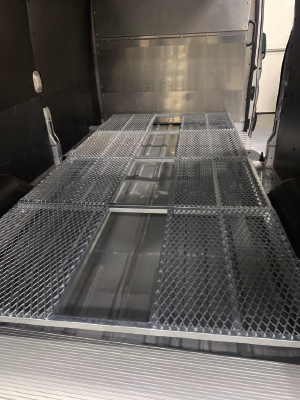
EMPHASIS ON EASY
The Hide-A-Ramp’s unitized, no-drill floor-mounting concept uses the Ford Transit’s existing factory anchor points and nests between its wheel wells. During installation, a Transit’s anchor point bolts and D-rings are first removed. The Hide-A-Ramp’s steel fasteners are then positioned and finally, the factory anchor point bolts and D-rings are reapplied. The design keeps the Transit’s anchor points in their original position with unobstructed and fully functional D-rings.
Because no drilling is required for installation, the Hide-A-Ramp and its housing components assemble quickly and do not foster corrosion, as the integrity of the van’s original floor structure remains uncompromised. Further, all components of the ramp and housing combined weigh only 350 lbs.
One of the most versatile aspects of the Hide-A-Ramp is that it allows for other common van upfits to continue to be used. The unit won’t hamper the installation or use of shelving, racks, or other storage solutions, making the Hide-A-Ramp compatible for myriad work truck applications.
The patent-pending Hide-A-Ramp is designed and manufactured by National Fleet Products in Buffalo, Minnesota, using American-made materials. Though initially engineered for the Ford Transit, the Hide-A-Ramp is also compatible with the Mercedes Sprinter, Ram ProMaster, and a number of popular service bodies. The company is designing versions of the Hide-A-Ramp for additional makes and models.
FOR MORE INFORMATION
Find out more about National Fleet Products and its Hide-A-Ramp solution for Ford Transit vans, visit www.nationalfleetproducts.com.


